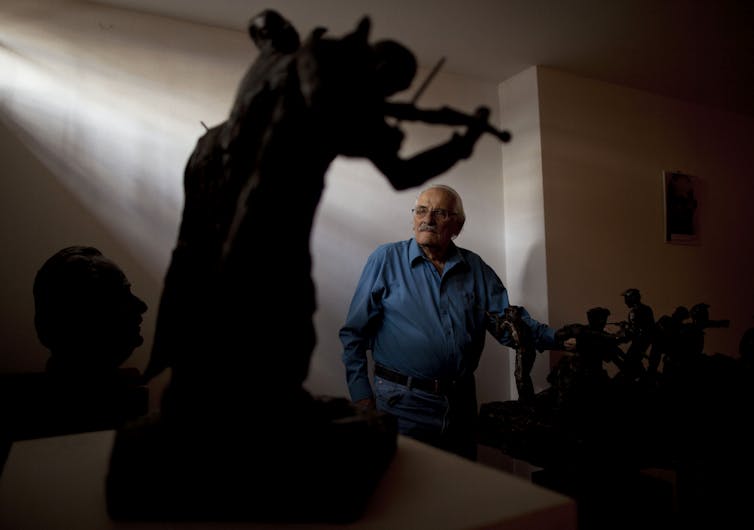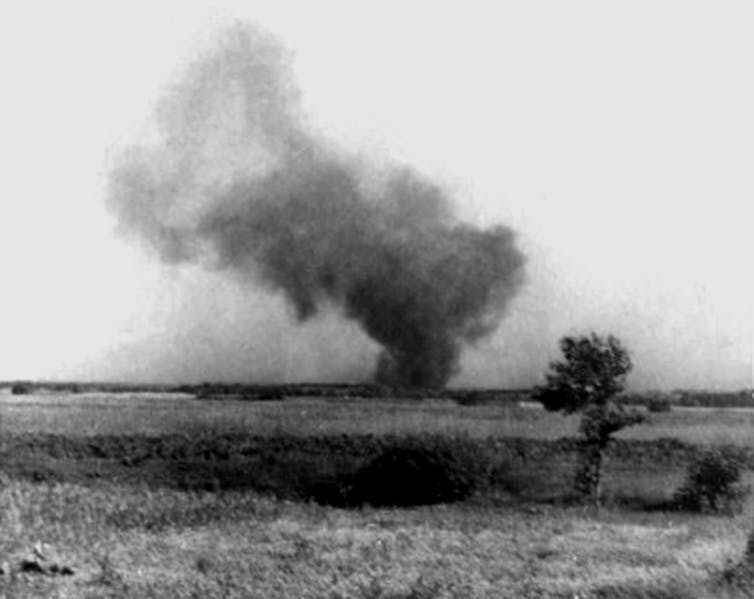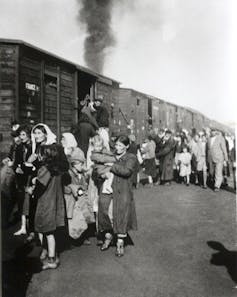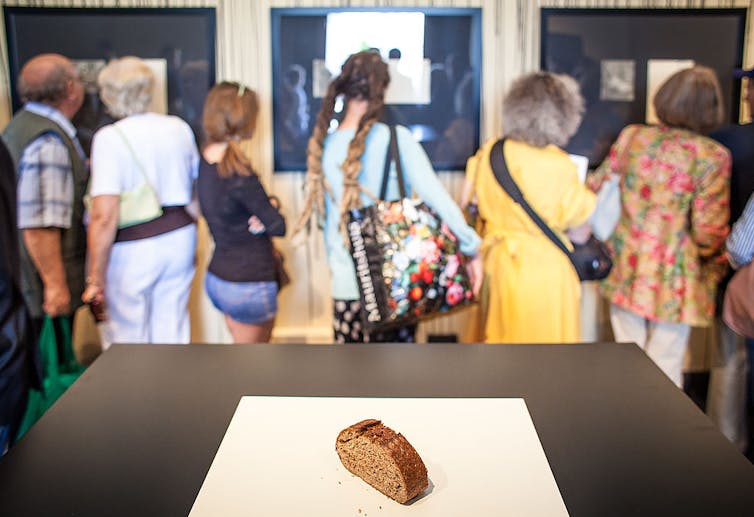
Experts in autocracies have pointed out that it is, unfortunately, easy to slip into normalizing the tyrant, hence it is important to hang on to outrage. These incidents which seem to call for the efforts of the Greek Furies (Erinyes) to come and deal with them will, I hope, help with that. As a reminder, though no one really knows how many there were supposed to be, the three names we have are Alecto, Megaera, and Tisiphone. These roughly translate as “unceasing,” “grudging,” and “vengeful destruction.”
Last week was Yom HaShoah (Holocaust Remembrance Day) and I was planning to use this article, but the fact that is was also income tax deadline weekend caused me to save it a week so that there would be less distraction and people would be able to think about it – about what we can do every day, to survive fascism and to help others survive fascism.
Some of us, of course, are living under fascism more than others. California and Florida may both have Disney theme parks, but living in one is a very different experience from living in the other – and that is particularly true for marginalized groups, but there is some effect on everyone. No one survives fascism alone.
==============================================================
Defying the Holocaust didn’t just mean uprising and revolt: Remembering Jews’ everyday resistance on Yom HaShoah and year-round

AP Photo/Oded Balilty
Chad Gibbs, College of Charleston
Richard Glazar insisted that no one survived the Holocaust without help. To this Prague-born Jewish survivor, who endured Nazi imprisonment at Treblinka and Theresienstadt, plus years in hiding, it was impossible to persevere without others’ support. Glazar conceded that some of his fellow Treblinka survivors were “loners,” but he nevertheless believed that they “survived because they were carried by someone, someone who cared for them as much, or almost as much as for themselves.”
Carrying someone else took many forms. For fellow Treblinka prisoner Samuel Goldberg, a Polish Jew born in a small town called Bagatelle, it was the moment the women of his work detail stood up to a guard to save Goldberg’s life. For those around Glazar, it was the times he brought them more to eat because his position as a fence builder gave him chances to buy food outside the camp. Still more prisoners benefited from a friend willing to literally hold them up during roll call so no guard would notice they were sick – a near-certain death sentence.
In a place meant to destroy all Jewish life, the smallest acts of support and comfort were resistance.
On Aug. 2, 1943, the Treblinka II extermination camp in Nazi-occupied Poland was the site of one of the most dramatic acts of armed rebellion throughout the Shoah, as the Holocaust is called in Hebrew. Several hundred prisoners managed to escape, though most were recaptured and killed. Nonetheless, at least 70 people survived to recount what happened there. Without their actions, the camp might have continued to operate, and we would likely know next to nothing of its history.
In years of research on this extermination camp, I’ve come to place as much importance on the long trail of smaller acts as on the famous day itself. Long before the revolt, resistance was commonplace at Treblinka. It had to be. Here and elsewhere, prisoner revolt would have been impossible without those everyday acts of support that laid foundations for more.

Franciszek Ząbecki/Wikimedia Commons
Defiance and dignity
Between July 1942 and November 1943, Nazi Germany killed as many as 925,000 people at Treblinka II. The vast majority of these victims were Jews, though the regime also murdered several thousand Romani people there.
This terrible place was unlike most other Nazi camps in that its sole purpose was the destruction of life. There were no slave labor industries or construction projects. The Jews responsible for the revolt were among the several hundred men and women kept alive to maintain facilities, sort the belongings of the dead, and dispose of the bodies. As the historian Michael Berenbaum put it, Treblinka was “a factory whose end product was dead Jews.”
In such a hell, life itself is resistance, but those held at Treblinka pushed back against Nazi designs for their destruction in every way possible. Early organized efforts took the form of escapes to warn other Jews. Abraham Krzepicki, for example, escaped Treblinka and went back to the Warsaw Ghetto to tell of what the camp really was – and later died there, fighting in the ghetto’s 1943 uprising.

Wikimedia Commons
These messengers of truth helped expose Nazi lies and give others the chance to try to go into hiding, fight or jump from trains.
Still, most people targeted by the Third Reich could not avoid transport to Treblinka or other camps even if they knew what awaited them there. For some, resistance was the way they carried themselves on the way to a certain death, such as saying prayers like the Shema Yisrael. Condemned for being Jewish, they steadfastly remained so to the end.
Samuel Willenberg, who was the last survivor of the Treblinka revolt when he died in 2016, remembered how a young woman named Ruth Dorfmann asked only if the gas would hurt, and calmly acted with such unshakable dignity that he felt compelled many years later to sculpt her final moments.
‘Choiceless choices’
Court testimonies, oral histories, survivors’ memoirs and other sources show that over months of concerted planning, Treblinka prisoners’ “Organizing Committee” laid the groundwork for the August rebellion by building a network of trusted men and women. Organizers found ways to place them in jobs that gave prisoner planners complete access to the camp.
That process was a winding and perilous road. Three earlier plans failed, and Nazi guards killed many Jews they suspected of resistance. It took at least eight months of concerted effort to finally pull off the revolt.
Though resistance at Treblinka eventually meant armed revolt, it could not have achieved that end without the countless little rebellions that came before. The same was true in Warsaw and throughout Nazi-controlled Europe. At its core, resistance is the way a person or a people chooses to stand against the challenges thrown at them. That holds true even if those options are what Holocaust scholar Lawrence Langer called “choiceless choices” between one terrible outcome and another.
In the Warsaw Ghetto, where hundreds of thousands of Jews were crammed into inhumane conditions, residents held each other up by establishing soup kitchens and clandestine schools, organizing the removal of waste to prevent disease, and setting up everyday events to help people feel normal, even for one moment.

Wojtek Radwanski/AFP via GettyImages
Warsaw Jews worked to archive what they endured and documented the medical effects of the starvation they faced. Both acts demonstrated hope for a future that would remember their suffering and use its lessons to ease the pain of others.
Yom HaShoah, the annual day of remembrance for the Holocaust established by the Israeli government, occurs on the 27th of Nisan in the Hebrew calendar: the start of major fighting during the Warsaw Ghetto Uprising. Thousands died in the Germans’ brutal retaliation.
A more complete picture
The full name of Yom HaShoah is “Holocaust and Heroism Remembrance Day” – which, along with its tie to the Warsaw Ghetto, links remembrance with resistance in no uncertain terms. This pairing held great importance for Israel’s identity as a new state and for a people so deeply wounded by years of terror.
Whenever we remember the Holocaust, we should remember the small rebellions, the individual stands, and the little acts of caring that Glazar found so important. Only in seeing that wider picture of everyday struggles can we understand the true variety and scope of resistance.![]()
Chad Gibbs, Assistant Professor of Jewish Studies, College of Charleston
This article is republished from The Conversation under a Creative Commons license. Read the original article.
==============================================================
Alecto, Megaera, and Tisiphone, if we haven’t already begun thinking about what we can do, not just to survive but to help as many to survive as possible, the time is now. Before the camps open. Because we don’t want it to get to that point.
The Furies and I will be back.

Sorry, the comment form is closed at this time.